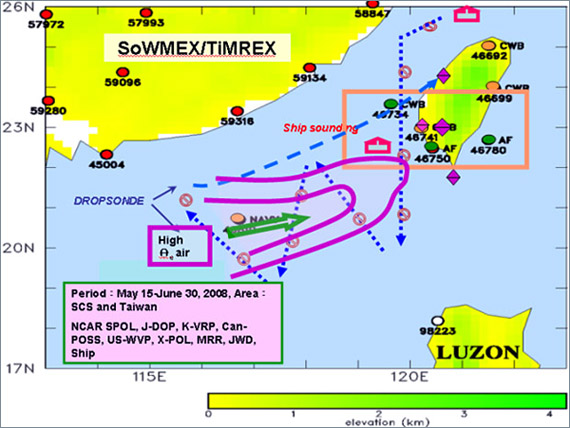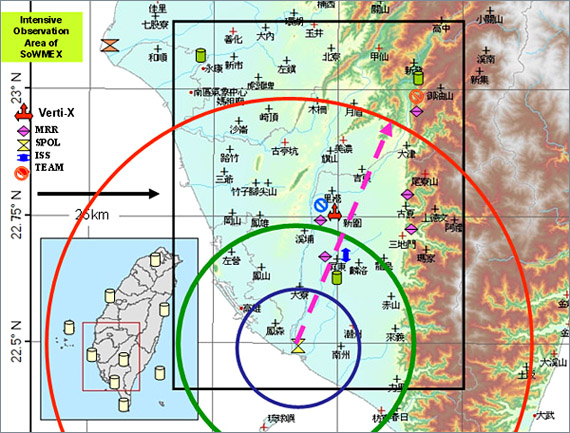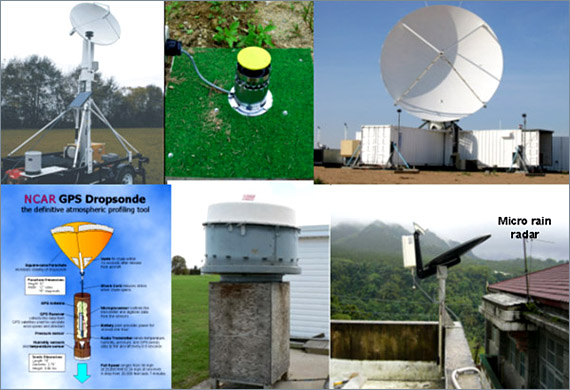
 |
|
Taiwan and United States are going to conduct a joint field experiment during the period of May 15 to June 30, 2008 at the western plain and mountain slope region of southern Taiwan. It is called Southwest Monsoon Experiment/Terrain-influenced Monsoon Rainfall Experiment (SoWMEX/ TiMREX). The goal of the program is to improve the capability of quantitative precipitation estimation and forecasting (QPE/QPF) during the Asian Summer Monsoon season. The localized heavy rainfall events frequently lead to floods and landslides resulted in casualty and heavy property damage in the Taiwan area. SoWMEX/TiMREX provides a unique opportunity to advance our basic understanding of physical processes leading to development of heavy orographic precipitation through intensive field observation campaign. SoWMEX/TiMREX provides an unprecedented opportunity for complementing the science of previous investigations in the general area of orographic precipitation. The primary observational facilities to be deployed at southern Taiwan include: NCAR SPOL (S-band polarimetric Doppler radar system), TEAM-Radar (X-band mobile polarimetric Doppler radar system), and MRR (Micro rain radar systems). In addition to these advanced radar systems, Taiwan will provide upstream soundings by operating dropsondes and ship soundings over the northern boundary of South China Sea.
The major expectation and contribution of SoWMEX/TiMREX is to provide better data set for understanding of the kinematic and thermodynamic characteristics of the southwesterly prevailing flows over the ocean upstream during Asian summer monsoon. It is anticipated that rainfall prediction products during the season will be greatly improved with this extensive observation campaign. The rainfall products will be valuable not only for early warning of flood and landslide but also for regional water resource management. The primary funding supports are from National Science Foundation of USA and National Science Council and Central Weather Bureau of Taiwan.
A pilot experiment has been conducted in May-June 2007. Dropsonde observations in 5 consecutive days were undertaken over the Taiwan Strait for a heavy rain event in central and southern Taiwan. Deep and wide spread low level moisture-abundant southwesterly were observed. Organized convective systems formed over the strait and propagated eastward producing heavy rain over the sloping area of Central Mountain Range. Data assimilation tests using these dropsonde observations are performed to simulate the evolution of the organized convections in high resolution mesoscale model. Research work using this data set for a better initial data description is now under investigation. |
|
|
|
The observation strategy of SoWMEX/TiMREX. The dot blue indicates the flight route of Astra
jet for dropsonde releasing and circles are locations of upper air sounding stations
|
 |
|
|
|
The intensive observation area of SoWMEX. The symbols indicate different observational
instrumentations. The center of the circles is SPOL location and the circles are with
range of 12.5, 25, and 50 km in distance, respectively.
|
 |
|
|
|
Rotate clockwise from upper left: Japan x-band Doppler radar system, JW collision type
disdrometer, US-NCAR S-band polarimetric (SPOL) radar system, Micro rain radar with
wavelength of 1.25 cm, vertically pointing rain profiler, and NCAR GPS dropsonde.
|
 |
